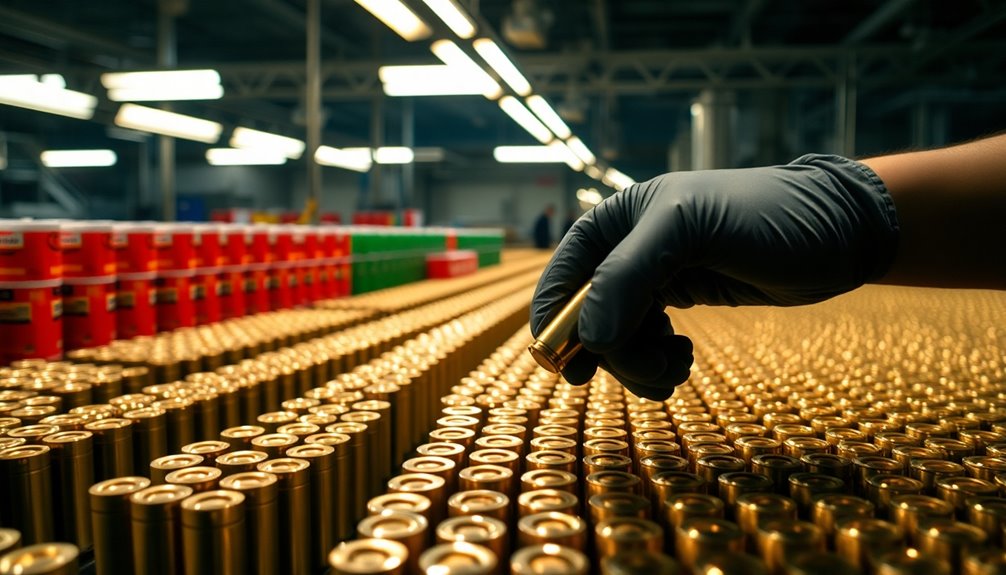Navigating private placements in ammunition manufacturing requires understanding various risks. You've got market consolidation, with a few major players dominating, leading to pricing power and supply issues. National security risks, driven by outdated facilities and foreign suppliers, complicate matters. Regulatory challenges add layers of compliance, while ESG factors emphasize worker safety and environmental concerns. You also need to consider the dynamics of private equity investments and the need for modernization within the industry. As you explore these facets, you'll discover how a well-rounded risk assessment can guide your investment decisions more effectively.
Key Takeaways
- Assess market dynamics, noting the dominance of major players and the impact of limited competition on pricing and supply.
- Understand regulatory requirements, including licensing, compliance with ATF regulations, and state-specific laws affecting investment in ammunition manufacturing.
- Evaluate national security risks associated with supply chain vulnerabilities and foreign ownership of production facilities.
- Consider the need for modernization and capacity building to enhance production efficiency and meet military demands.
- Analyze ESG factors, focusing on worker safety, environmental impacts, and public safety concerns related to military-grade ammunition sales.
Market Consolidation Effects
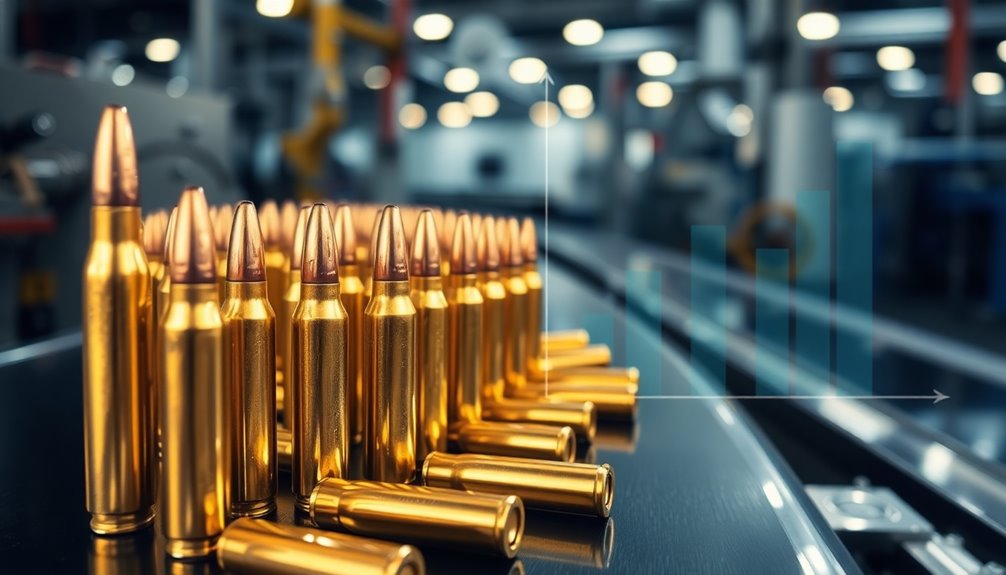
As the ammunition manufacturing industry faces increasing market consolidation, you'll notice its effects ripple through pricing and supply dynamics. A few large companies, like Vista Outdoors and Olin Corporation, now dominate the market, controlling multiple well-known ammo brands such as Federal and Winchester.
This concentration allows them to exert significant influence over both pricing and supply. With limited competition, you might find that fewer bids are submitted for government contracts, resulting in higher prices—as demonstrated by Olin's $99 million contract that had just one bid. The collapse of Remington has also reduced the number of independent manufacturers, further tightening the market.
The high barrier to entry in the ammo market worsens supply constraints, leading to shortages affecting hunters, law enforcement, and military operations.
The boom-and-bust cycles, often driven by political shifts, complicate the situation for smaller companies. Additionally, ongoing supply chain strains, worsened by the COVID-19 pandemic, create further challenges.
National Security Risks
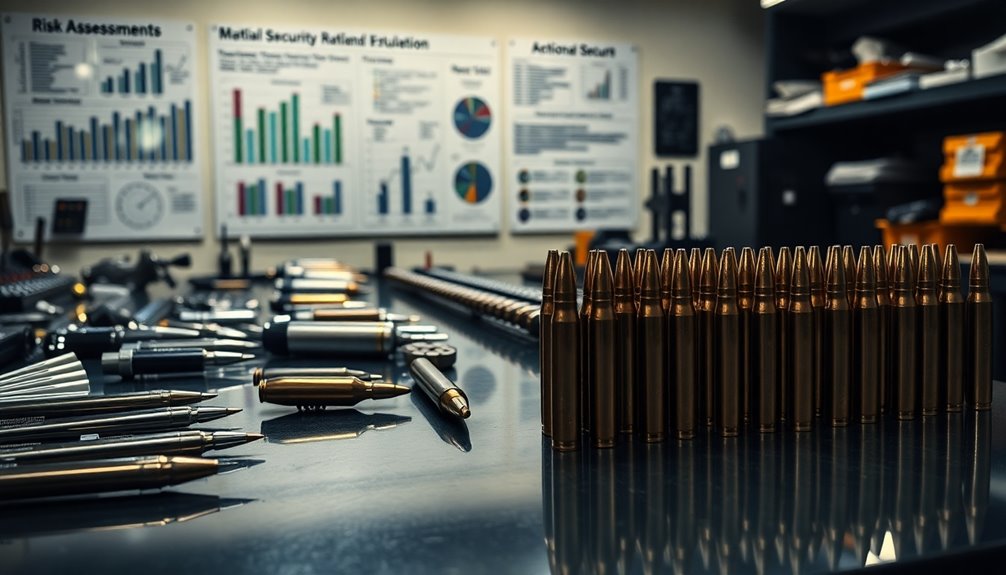
National security risks in ammunition manufacturing are increasingly alarming, especially given the industry's heavy dependence on foreign suppliers. With the Department of Defense relying on over 50 foreign suppliers, including some from China, you're exposed to significant vulnerabilities. This reliance can lead to production disruptions during global conflicts, threatening military readiness.
Additionally, critical facilities like the Lake City Army Ammunition Plant, which produces 85% of the military's small caliber ammunition, represent a single point of failure. If compromised, these plants could halt operations entirely. The Holston Army Ammunition Plant's sole production of specific explosives further heightens this risk.
Technological and infrastructural deficiencies also play a role. Many U.S. facilities are outdated, lacking modern automation, which increases the likelihood of accidents and slows output. Ammunition production vulnerabilities highlighted by the war in Ukraine underscore the urgent need for modernization and increased capacity.
Furthermore, cybersecurity threats loom large; cyberattacks can disrupt manufacturing and jeopardize sensitive information, especially given the interconnected nature of global supply chains.
Lastly, the potential for foreign ownership raises concerns about production loyalty and influence from adversaries. Overall, these national security risks necessitate a reevaluation of current practices and supply chain strategies.
Private Equity Dynamics

The landscape of ammunition manufacturing is shifting, influenced by private equity dynamics that are reshaping investment strategies within the sector.
You'll notice an impressive 41.7% increase in M&A activity year-to-date in 2024 compared to the previous year. Fewer restrictions from Texas-based pension LPs are paving the way for these investments, making it easier for private equity firms to engage. Notably, platform acquisitions now represent 20.6% of total deals, a significant change from earlier years. Maximizing IRA contributions can provide additional capital that private equity firms may leverage for such investments.
Investor motivations focus on maximizing shareholder value, as seen with Vista Outdoor's intent to explore mergers, bolstered by competitive bidding scenarios. For instance, a U.S.-based private investment firm recently offered $2.08 billion, outbidding CSG's $1.96 billion offer, highlighting the aggressive landscape. This competitive environment is further intensified by CSG's acquisition of Vista Outdoor Inc. ammunition brands for $1.9 billion.
While challenges like raw materials shortages persist, entrenched players maintain significant pricing power to navigate these hurdles. The consistent core consumer demand, alongside a diverse product offering, makes this sector appealing.
However, keep an eye on CFIUS regulations and Pentagon reviews, as they play crucial roles in foreign acquisitions and overall market stability.
ESG and Ethical Implications

ESG (Environmental, Social, and Governance) considerations have become increasingly vital in the ammunition manufacturing sector, where the balance between operational efficiency and ethical responsibility is often tested.
Worker safety is a significant concern, especially given the high-risk nature of handling explosive materials. The lack of automation and outdated infrastructure in facilities leads to increased risks of accidents, as highlighted by recent fatalities like Lawrence Bass's at the Lake City Army Ammunition Plant. Modernization is essential to protect employees and enhance safety measures. Furthermore, a focus on effective modernization could significantly reduce the risk of accidents and improve overall employee safety.
On the environmental front, the production process involves hazardous materials that can pollute if not managed properly. Many older facilities may not meet current environmental standards, which is a serious concern for nearby communities. Thus, incorporating environmental upgrades in modernization efforts is crucial.
Ethically, the sale of military-grade ammunition to civilians poses risks to public safety, especially when taxpayer-funded products contribute to mass shootings. Advocates are pushing for stricter regulations to prevent such distributions.
Balancing these ESG factors ensures not only compliance but also fosters public trust and maintains national security in an increasingly scrutinized industry.
Investment Restrictions Overview

When considering investments in ammunition manufacturing, it's crucial to understand the myriad of restrictions that govern the industry. Federal law mandates that anyone involved in importing or manufacturing ammunition must secure a license from the Attorney General. Additionally, licensed manufacturers and importers must label each product with specific details, such as model and caliber. Many states, including California and Massachusetts, impose their own licensing requirements for vendors selling ammunition, which could complicate your investment strategy. You also need to comply with ATF regulations, which include maintaining accurate records of sales and conducting background checks in certain states. These regulations can significantly affect the operational capabilities of your investment. Moreover, unique identification numbers must be assigned to each manufactured ammunition component, ensuring traceability and compliance with federal standards. Hazardous materials regulations further complicate matters, as ammunition and its components are classified accordingly, requiring adherence to DOT guidelines for safe transport. State-specific restrictions can add layers of complexity; for example, California mandates background checks at the point of sale, while New Jersey requires a valid firearms purchaser card for ammunition purchases. Understanding these multifaceted regulations will help you navigate the investment landscape more effectively.
Regulatory Challenges

Navigating the regulatory landscape in ammunition manufacturing presents significant challenges that can impact your investment strategy. You need to be aware that federal law mandates obtaining a license from the Attorney General for importing, manufacturing, or selling ammunition.
Each licensed manufacturer must also identify firearms and ammunition with specific details, which adds layers of compliance. In states like California, you'll face additional hurdles, including mandatory background checks for all ammunition sales, even those between unlicensed individuals. This requirement extends to record-keeping and reporting lost or stolen ammunition to law enforcement. Furthermore, California Penal Codes outline specific regulations on ammunition that must be adhered to.
Other states, such as Massachusetts and New Jersey, have their own licensing requirements, complicating sales further.
Transportation and storage regulations are strict as well. You must comply with PHMSA regulations, ensuring correct packaging and potentially obtaining EX Approval for shipments.
Additionally, annual risk assessments for physical security at facilities are essential, particularly for Army installations.
Failing to navigate these complexities can lead to legal repercussions and financial losses, making it crucial for you to stay informed and compliant with all applicable regulations.
Modernization Needs
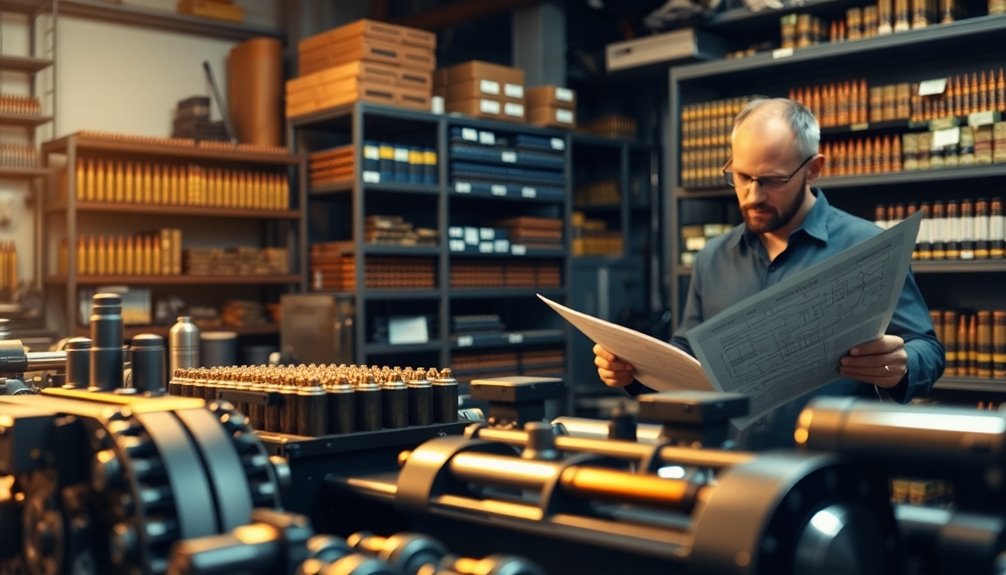
In light of aging infrastructure and the pressing need for modernization, the Army's ammunition manufacturing facilities face significant challenges. Most of these plants, built during World War II, are now 58 years old, far beyond their expected lifespan. With only 16 plants remaining, down from 84, the urgency for upgrades becomes even clearer. Many facilities are on the National Historic Registry, complicating structural changes. Immediate safety and environmental issues are prioritized, requiring funding to address these must-do projects.
Since 2009, the Army has invested $3.2 billion in modernization efforts, but an additional $14 to $16 billion is necessary by 2035 to fully revamp the ammunition industrial base. Currently, over 100 modernization projects valued at $1.5 billion are underway, while nearly 400 more, costing over $10 billion, have been identified for the future. Only 16 operational ammunition plants remain, underscoring the critical need for substantial investment in upgrades.
Adopting advanced technologies like robotics and artificial intelligence can streamline production processes, improve quality, and reduce labor needs. With a goal of producing 100,000 155 mm shells per month by 2025, modernizing these facilities is essential to meet national defense demands effectively.
Capacity Building Strategies
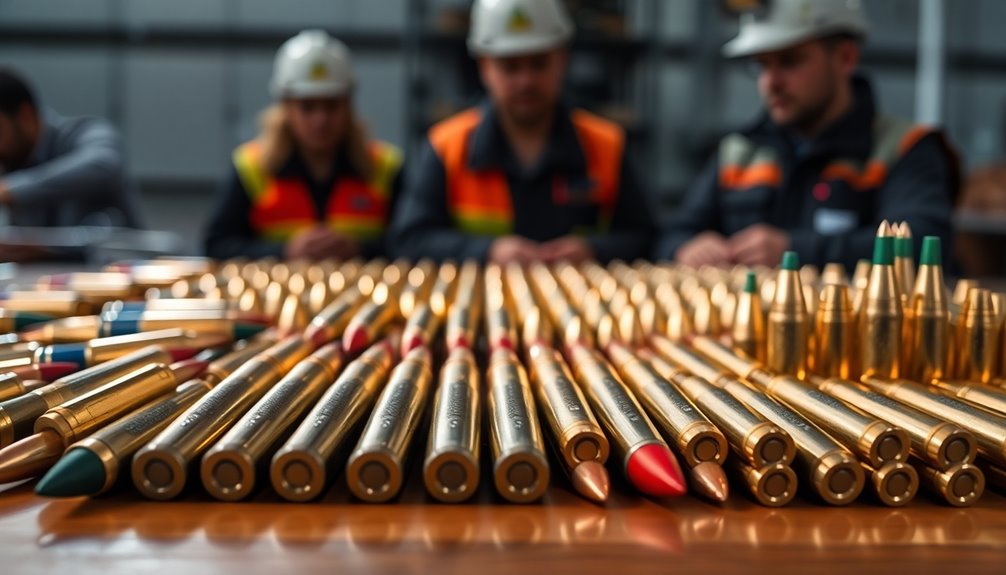
To effectively address the challenges facing ammunition manufacturing, you must implement robust capacity-building strategies that enhance production capabilities and strengthen supply chains.
Start by adapting your Planning, Programming, Budgeting, and Execution (PPBE) process to include portfolio management and agile acquisition methods. This agility allows you to increase production rates by adding shifts and investing in supply chain resilience, similar to the U.S. Army's efforts to double 155mm artillery production. The current production levels are insufficient for sustained military engagement, highlighting the need for increased munitions production rates.
Implement multiyear procurement contracts to incentivize industry investments in efficiency and capacity expansion.
Focus on reducing manufacturing lead times to accelerate inventory rebuilding, aligning your goals with operational priorities like producing 100,000 155mm artillery projectiles monthly by 2025.
Strengthening your supply chains is crucial.
Utilize second sourcing strategies to minimize bottlenecks and address obsolescence through planned technology refreshes.
Promote investments in critical areas via cost-sharing with industry partners, and enhance coordination between government and companies to eliminate hurdles.
Frequently Asked Questions
What Are the Key Players in the Ammunition Manufacturing Industry?
In the ammunition manufacturing industry, you'll find major players like General Dynamics and Northrop Grumman, known for their extensive range of military munitions.
BAE Systems and Nammo AS also stand out, producing various calibers and specialized ammunition.
Additionally, companies like Rheinmetall AG and Nexter Group lead in Europe, while CBC Global Ammunition and Hanwha Corporation provide diverse products globally.
These key players drive innovation and respond to increasing demand across different markets.
How Does Ammunition Production Impact Local Economies?
Ammunition production significantly impacts local economies by creating jobs and stimulating growth.
You'll find over 150,000 direct jobs in manufacturing, sales, and logistics, with tens of thousands more in related sectors.
The industry contributes billions in tax revenue, funding public services and conservation efforts.
As it grows, it drives economic activity, supporting local businesses and communities.
What Technological Advancements Are Influencing Ammunition Manufacturing?
Technological advancements are reshaping ammunition manufacturing in several ways.
You'll notice the integration of additive manufacturing, enabling rapid prototyping and complex designs. Advanced materials like polymer composites and bi-metal cartridges reduce weight and enhance performance.
Cased-telescoped ammunition offers improved range and precision. Plus, automation ensures consistent quality, while modern design techniques elevate accuracy.
Together, these innovations are revolutionizing how ammunition is produced, enhancing capabilities for various applications.
What Role Do International Treaties Play in Ammunition Production?
International treaties play a crucial role in ammunition production by establishing regulations to ensure responsible manufacturing and trade.
They require you to assess risks, prevent illicit trafficking, and maintain control systems.
By adhering to these treaties, you help prevent the diversion of ammunition for unlawful purposes, promote transparency, and facilitate international cooperation.
Compliance not only protects your interests but also contributes to global security by mitigating risks associated with ammunition production and trade.
How Can Investors Assess the Long-Term Viability of Ammunition Companies?
To assess the long-term viability of ammunition companies, you should analyze their market position, financial health, and production capacity.
Look at their competitive landscape, including any monopolistic tendencies that could impact pricing. Evaluate their regulatory compliance and how adaptable they're to changing policies.
Check for transparency in financial reporting and the company's ability to modernize facilities.
Conclusion
In conclusion, when assessing private placement risks in ammunition manufacturing, you need to consider market consolidation effects, national security risks, and the dynamics of private equity. Don't overlook ESG implications and investment restrictions, as well as regulatory challenges. Finally, focus on modernization needs and capacity building strategies to ensure sustainable growth. By understanding these factors, you can make informed decisions and navigate the complexities of this unique investment landscape more effectively.

